We are in a very unique fishing situation here and now in 2024, and I think it's one that no one is talking about: the fact that we now have the least amount of fish to occupy the most amount of water.
This scenario really sets the tone for how your fishing trips are going to go, and I call this scenario the "Most Water, Least Fish" scenario.
In this guide, I'll explain what it is, how it came to be, what it means for you and what you can do to make the most of it.
What is the "Most Water, Least Fish" scenario?
It's the scenario where you have the fewest fish to catch and the most water to find them in. It's something like the proverbial "needle in a haystack", with the needle being the fish you want to catch and the haystack being the marsh you have to look through.
It is arguable that — never before in Louisiana's inshore fishing history — has there been more water that inshore species can inhabit and the least amount of them to inhabit it.
This makes for difficult fishing. If there were more of them in a less amount of water, then it would be much easier to find and catch fish. But when you have a handful that are spread out few and far between, then finding and catching them becomes that much more difficult.
But this wasn't always the case! Which leads us to our next question:
How did Louisiana get to this "most water, least fish" situation?
I feel that we once had more fish. Well, actually, that's pretty much established fact. Just consider the graphs below:
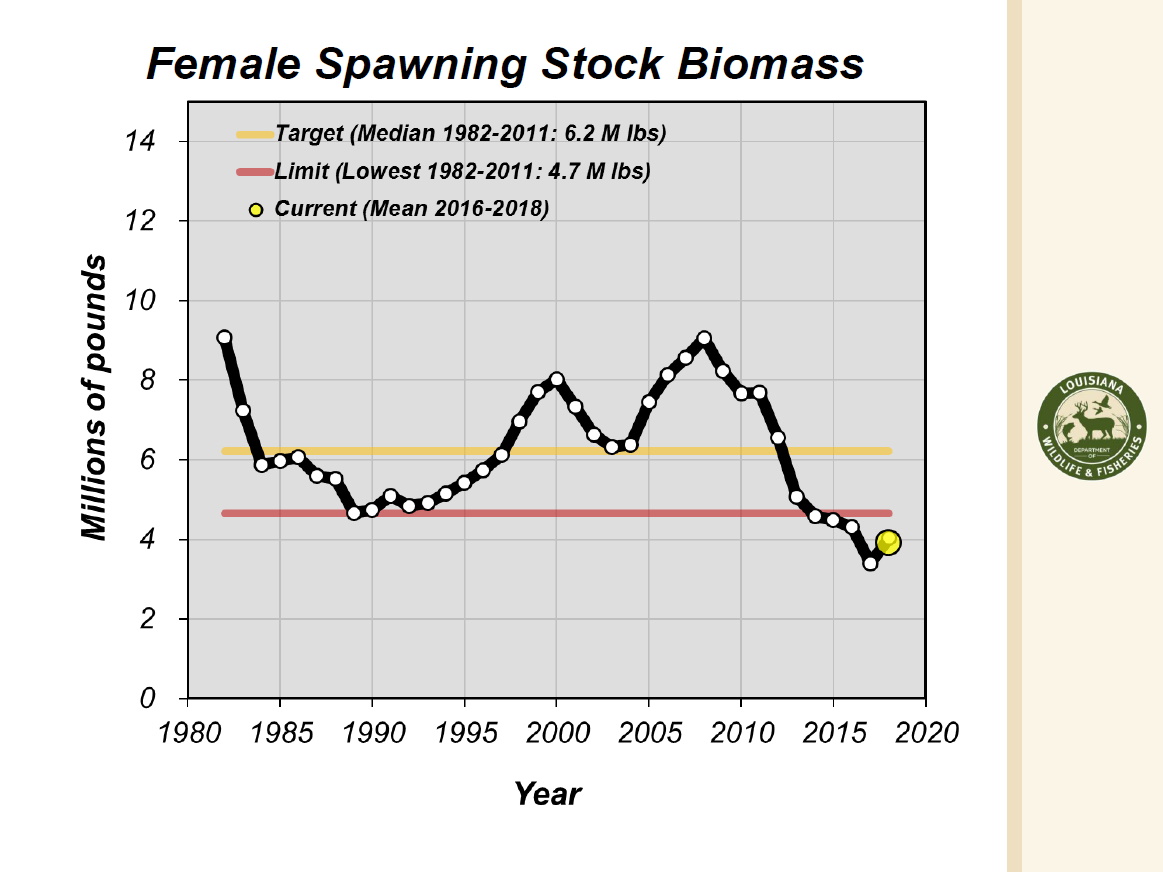
Click to Enlarge This graph represents the number of female speckled trout assessed by year.
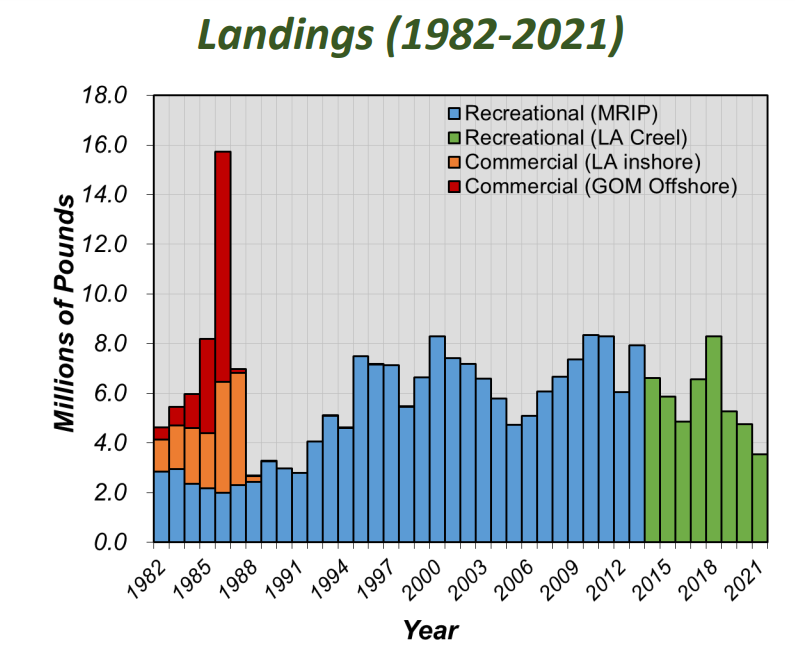
Click to Enlarge This graph shows that the redfish landings are nearly as bad as they were in the 1980s
But if we had so many speckled trout, redfish, flounder and more, then how did we get to have so few? It took a perfect storm to get us here, and I firmly believe that the record amount of flooding we saw from 2011 to 2020 had the largest role to play in this.
If you're not familiar with this record amount of rainfall that changed our coast, then I strongly recommend reading my article about the Freshening. This inundation of our coast with river water, combined with land loss and additional fishing pressure, impacted our inshore fishing so gravely that we had to:
So, in a nutshell, it was The Freshening that brought about these drastic changes. But something else also happened during this once-in-a-lifetime event:
The Freshening Reduced The Amount of Usable Habitat For Speckled Trout, Redfish & More
Before the record flooding of 2011-2020, there was as much usable habitat for speckled trout and redfish (or any inshore species) as there is now. But then the inundation of river water across Louisiana's coast changed that.
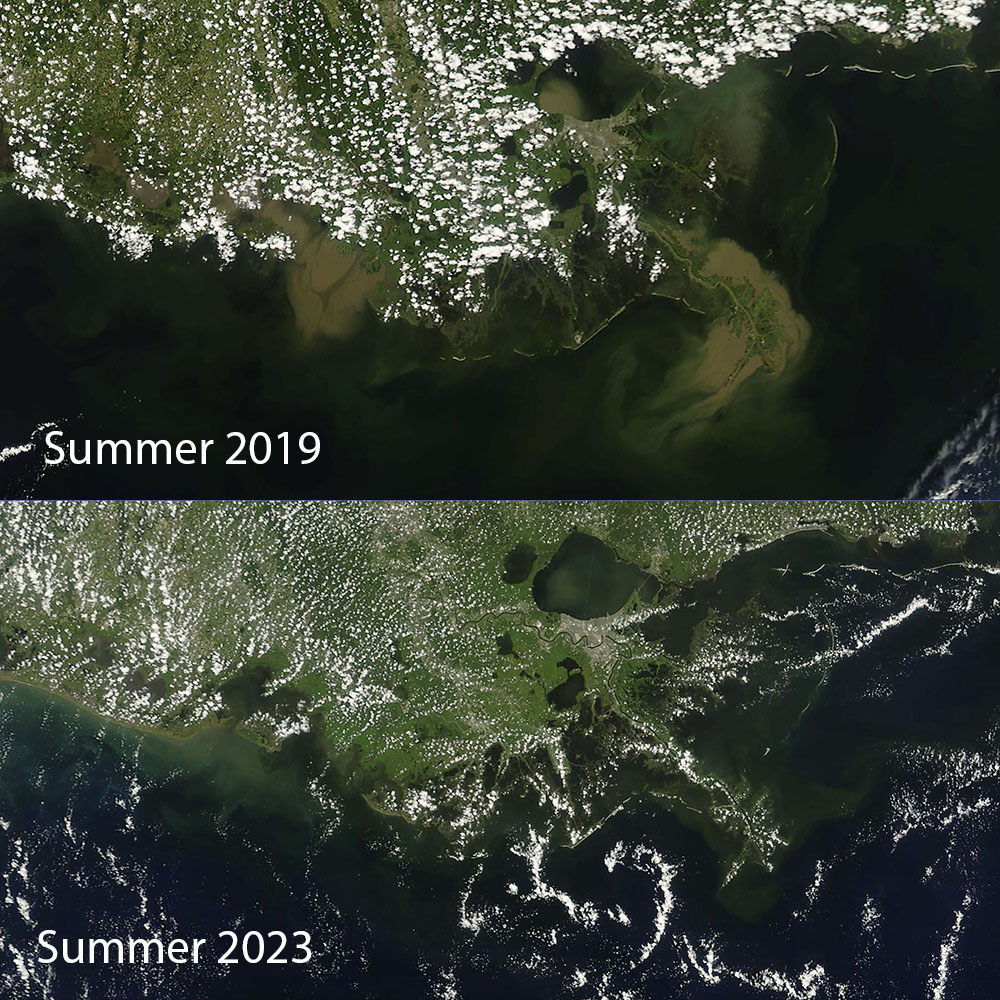
It's easy to see how the extra river water of the Freshening impacted Louisiana's coast. Note the algae bloom in Lake Borgne and Mississippi Sound in 2019.
Bodies of water that speckled trout, redfish and more could use to swim, feed and spawn in became covered in river water from top to bottom of the water column.
I think what happened next is that these fish were corralled into places where they were easily caught (The Great Wall of Chalmette is one example), or died from freshwater shock, predated upon by sharks and the like, and then — this is key — were unable to replenish their numbers because their spawning grounds were covered in river water.
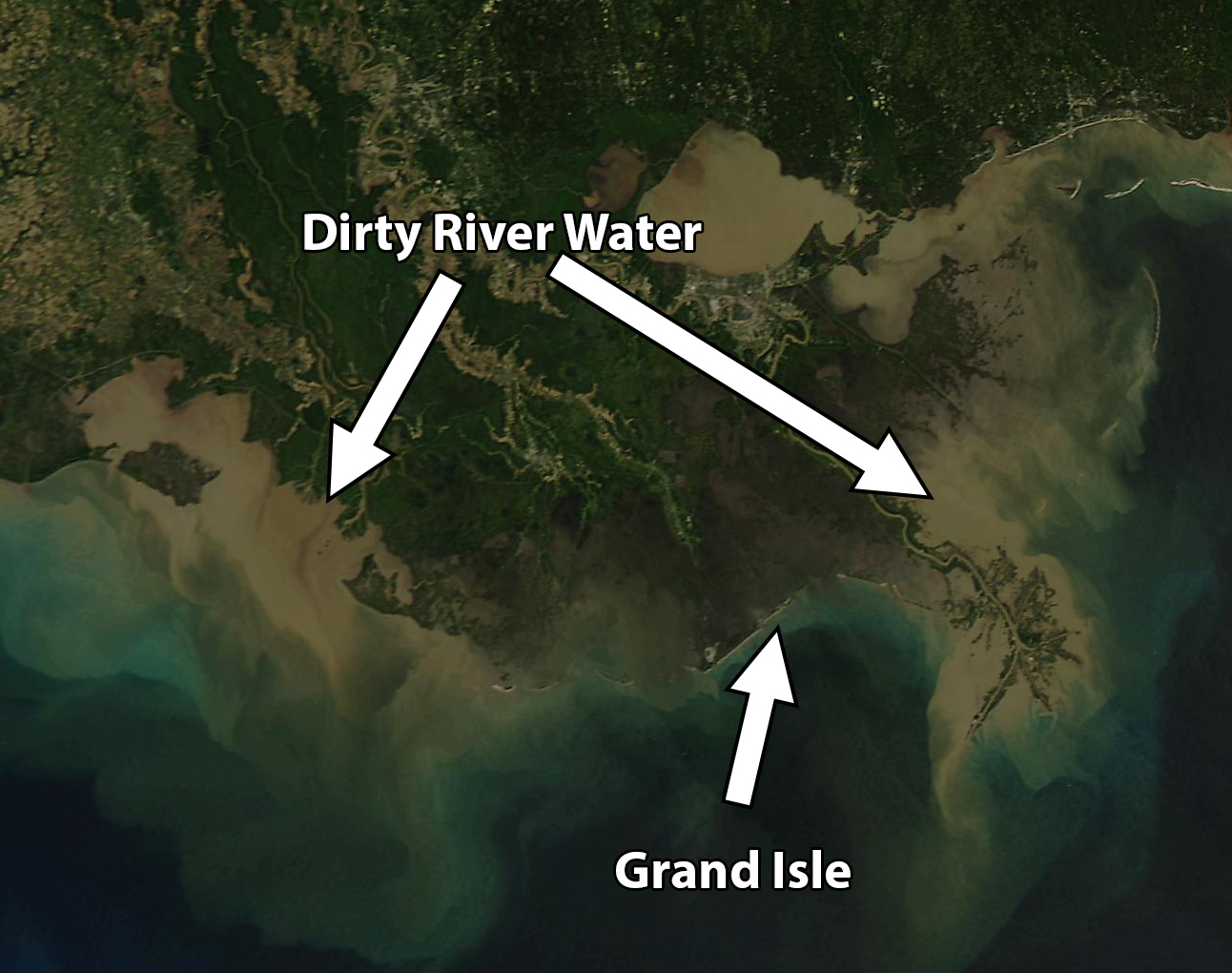
Obviously this applies to some places more than others. Grand Isle never saw the same amount of river water that the Lake Pontchartrain Basin did. I think that's why the speckled trout fishing remained to be so good there and still is.
By the way, if you're curious to know where to fish, consider this guide to Grand Isle that I wrote back in May.
Moving on: in Biloxi Marsh we saw oyster reef mortality rates upward of 100%. That's how catastrophic The Freshening was! It literally killed entire swaths of our inshore fishery from the bottom up!
Before the Freshening we had "most water, most fish" then went to "least water, most fish", where we still experienced good fishing. But once a few spawns were damaged, we progressed to "least water, least fish".
So how did we get to "most water, least fish"?
The Saltening: Most Water, Most Fish (to come)
The Freshening is over and has been since 2020. Bodies of water that were once inundated with river water have gone back to their former selves, and now that the rivers are low the fish have their habitat back. This is where we go from "least water, least fish" to "most water, least fish".
I've dubbed this new trend The Saltening. It's happened before and you can learn more about it in this article here.
Speckled trout, redfish and more can now spawn, they can increase their numbers and the good fishing we had before can rebound. We can get back to "most water, most fish", but that will take time. These fish don't grow overnight, especially redfish since they take upward of five years to become sexually mature.
Right now I feel that we are in the post-Saltening interim of "most water, least fish". What does this mean for you?
Well, if you want to catch limits of speckled trout and redfish, you need to consider two things:
Let's go over both and see what details you ought to consider to make this strategy work for you:
Covering More Water
If you had to find a needle in the proverbial haystack, then you're more likely to find it if you sift through more hay, yes?
The more hay you can pick through, the more likely you are to find the needle. Easy peezy.
Well, it's more or less the same thing with inshore fishing: the more water you cover the more likely you are to find the motherlode of fish.
In fact, I recently held a seminar titled Common Mistakes Inshore Anglers Make That Ruin Their Fishing Trips (and how to fix them) and one of the mistakes listed is "not fishing enough spots".
Most anglers tend to fish just a few spots. This pales in comparison to the 10+ I'll fish when starting from scratch.
In fact, if you watched the seminar (it's been recorded and uploaded to LAFB Elite), then you know I revealed that — on average — I'll fish thirteen fishing spots in order to find the one absolutely loaded down with trout (or redfish). That is, of course, when starting from scratch with no fishing intel to work with.
So don't get discouraged!
It's easy to launch the boat, fish a handful of spots, not catch anything and lose all drive to keep going.
But that's what you need to do: keep going. And it's best to know where to keep going, so I recommend picking out your fishing spots before launching the boat (more on that in a moment).
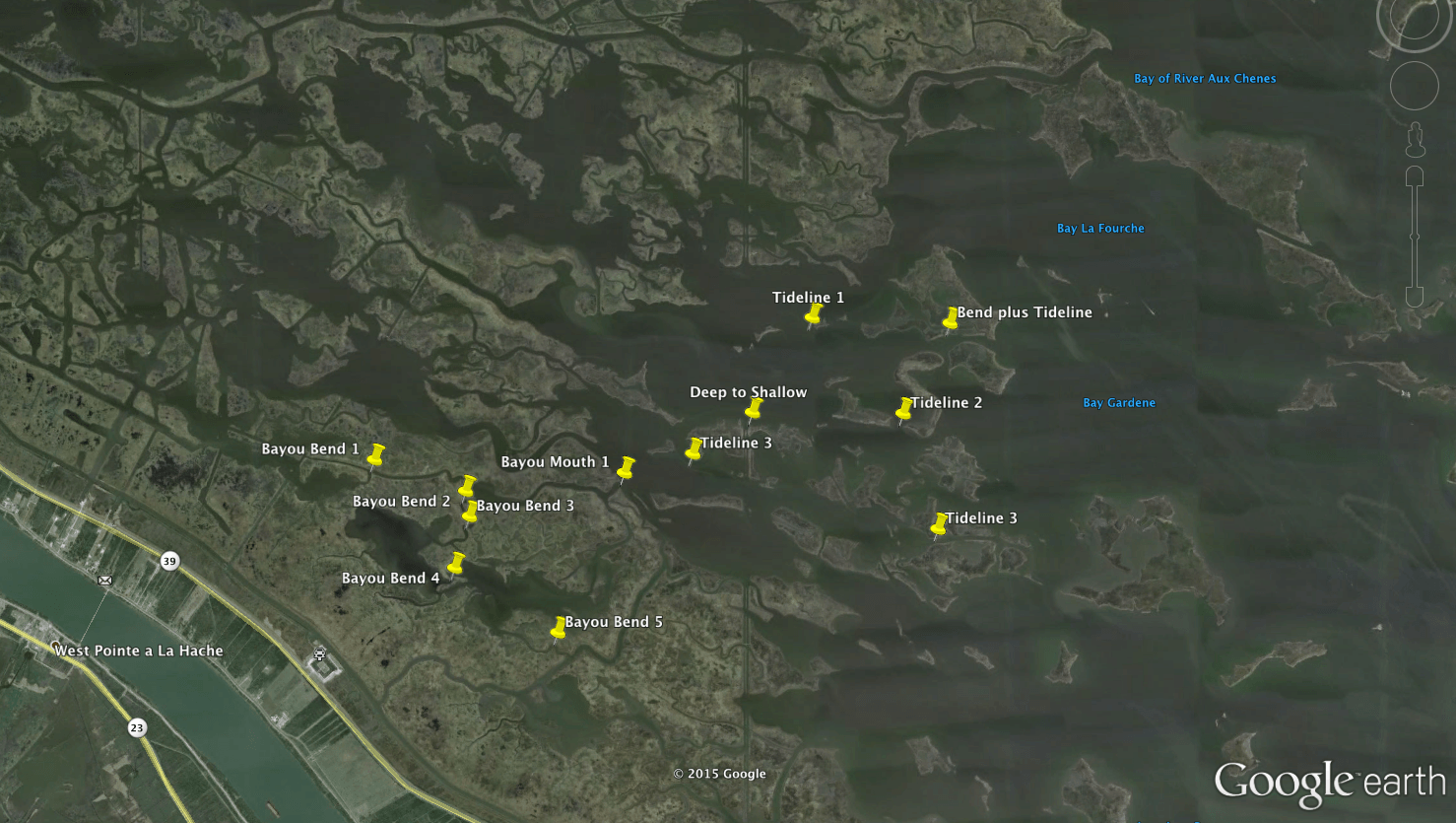
I like to have my fishing spots picked out before hand so I know where I'm going and what to do.
Consider this example catching speckled trout at Elmer's Island:
In fact, that's more or less what I did on a recent fishing trip to Elmer's Island: The first few stops didn't produce anything. In fact, I got out there for 5:30am and didn't catch my first trout until nearly 11am!
Yet I had been through this ringer a thousand times and knew what to do: just keep going. They are there, they just need to be found.
And I did, catching twelve keepers, which isn't bad considering that I had no intel, had no idea where to go, and didn't have a boat.
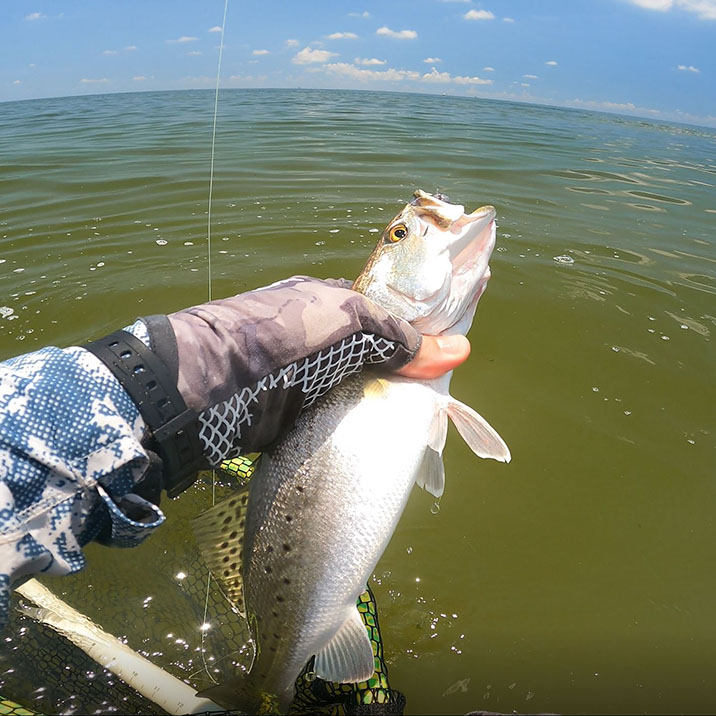
Elmer's was a good time! It was worth the drive and I can't wait to go back!
If I were to go back tomorrow, I'd know exactly where to go and I am confident that I'd limit out and leave them biting first thing in the morning.
By the way, if you're curious to know more about that fishing report, you can find it here inside the LAFB Elite Community.
But this recent fishing trip highlights more than just covering water. Consider this next strategy to implement:
Fish Somewhere More Productive (do an area change)
One of the reasons I ended up at Elmer's Island is because the fishing in that part of Louisiana has just been better than say, the Biloxi Marsh.
And that's saying something because I live in Slidell, much closer to the East Biloxi Marsh than Elmer's Island. That and I had to drive past a lot of other fishing destinations to arrive to one of Louisiana's barrier islands.
So why did I do this?
Well, because I'd rather hang the success of my fishing trip on an area that's been producing more consistently than an area that's closer and more familiar, but less productive. It really is that easy.
Two such areas that have been productive as of late have been Grand Isle and Venice. I already linked up my guide to summer fishing spots for Grand Isle above, and you will find the one I wrote for Venice at this link.
Why do some areas do better than others?
Some areas along Louisiana's coast just do better than other areas, and they all take their turn being "king of the hill" at some point in time.
For example, back in the late 1990s and early 2000s, Lake Pontchartrain was quite the destination for big speckled trout. Today, not so much. That's not to say that there are no big speckled trout there right now in 2024, but it is to say that — if I were looking for a bunch of Release Over 20 or Speckled Truth Citation trout — I would venture somewhere else.
Hell, it's not even size! I wouldn't go to Lake Pontchartrain for numbers, either! But do you know where I have seen great numbers come from recently? Grand Isle and Venice!
I think those areas do better because they're closer to the deeper (and saltier) water of the Gulf of America. There's more to it than that, and that's why I wrote those guides about them (find them linked above), but that's the overall gist of it.
At the end of the day, some areas just do better than others! You can spend years waiting for one area to turn on as you grind it out or you can go this week to the area that is kicking ass. It's your call.
The Absolute Best Thing You Can Do To Catch Speckled Trout & Redfish On Your Next Fishing Trip
Good fishing is out there, it's just separated by large swaths of unproductive water. All you need to do is fish more spots to find the fish you're targeting and consider going somewhere the fishing is more productive.
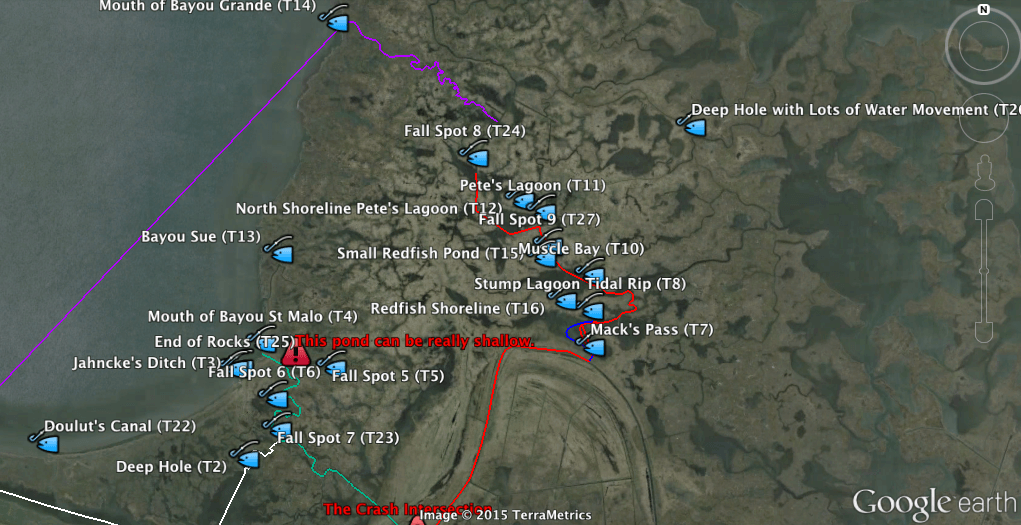
Your planned fishing trip should look something like this, and I can show you how to do it!
But there is something else you ought to consider...
When you fish more spots, you should pick out fishing spots based upon the conditions.
Specifically, you're looking at fishing spots based upon past, current and predicted conditions. Failing to do so — at the worst — could lead to disaster, like this time I got hit with a false neap tide or this other time I ran aground (where there used to be open water).
Or — at the best — you'll just catch trash fish and come back to the dock only to see everyone else cleaning fish. Bummer, dude.
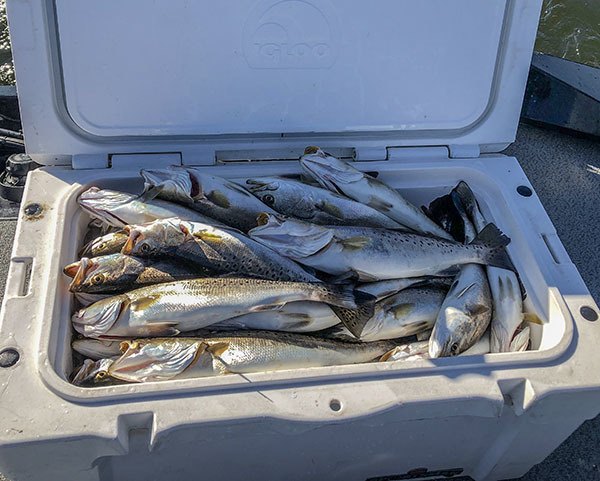
Do you want to catch a limit of fish or do you want to get skunked?
But there's a lot of things to consider when planning a fishing trip based upon the conditions:
This and more is what I teach inside Inshore Fishing 101. It's a complete course that details how to go from zero to hero on Louisiana's coast. But make no mistake! This is not some "beginner's course". Nope!
Imagine if I sat down with you and we detailed everything you need to know about the marsh, how it works, the fish that swim in it and how they behave throughout the year.
Then we'd go over the best way to identify good fishing spots, how to safely navigate to them and back, then the best way to fish your way through them and capitalize on the success you'll inevitably find.
That is what Inshore Fishing 101 is!
The only place you can find Inshore Fishing 101 is inside my membership, LAFB Elite. Inside LAFB Elite you'll discover my seasonal courses for spring, summer, fall and winter, as well as recordings of all my seminars hosted through the years.
Additionally, you'll find the LAFB Elite Community to be most helpful. There you'll meet like-minded inshore anglers who know the knowledge and process I teach, and can help you plan your own fishing trips. In fact, many of them were kind enough to leave a testimonial in support of my program:
Highly Recommend To Anyone Who Loves Inshore Fishing
Inshore Fishing 101 was an excellent experience. I learned a lot of good information.
I think the most important thing that I learned was how to use Google Earth Desktop to find new fishing spots and avoid hazards. I never realized how awesome of a tool it is.
Above all, I really enjoyed the attention to detail. I feel like the information inside this course is so broken down that anyone can understand it.
Wish I Had This Ten Years Ago
Back when I first started fishing 10 years ago I was looking all over for someone teaching something like Captain Devin's Inshore Fishing 101, but there was no one.
I think of the many, many days that my buddy and I were out running around trying to find fish and didn't know what's taught inside 101.
We didn't have a chance.
We didn't understand the conditions, the necessary tackle, the seasonal conditions that required different techniques, etc. But that has all changed now that I've completed Inshore Fishing 101.
It's so much more fun to understand the bigger picture and use a process to find and catch fish! And yes! We catch a boatload more fish!
Captain Devin knows his stuff!
I fished largemouth bass in Arizona’s Salt River reservoirs (Saguaro, Canyon, and Apache Lakes) for years, and then moved back to Louisiana after decades of being away.
I wondered if all that bass knowledge and skill would be useful here in saltwater. Devin has showed me how incredibly useful it is! I don’t regret for one microsecond the money I spend on his membership, LAFB Elite.
Inshore Fishing 101 is Convenient
I loved the easiness of going through Inshore Fishing 101, and that I could go back and redo a video lesson.
The content is outstanding! Devin is easy to listen to and follow along. His passion and knowledge of our fabulous fishery is something everyone that wants to better their game should consider.
I have done my best to transfer my knowledge of the marsh to my grandsons. They will watch Inshore Fishing 101, at a minimum.
No More Frustration
I too was frustrated with the many times I went and fished all day only to come home with little to nothing.
I have been an Elite member now for a couple of months, and while I haven't loaded the boat yet, I can say that I have learned a lot.
Some of the stuff that Devin teaches, I think that I already was doing but not understanding why. Plus I learned the things that "I didn't know that I did not know".
I am very pleased with LAFB Elite, and recommend it to anyone who's on the fence considering if they should join or not.
Like Devin says: it costs less that a bucket of live shrimp, so what do you have to lose?
Knowledge Gained Is Priceless
My experience was excellent, I found that the knowledge gained in Inshore Fishing 101 is priceless. I found that a lot of the things I thought I knew were not what I thought I knew. This course has expanded my knowledge and has already honed some of my skills.
I am forever grateful for finding LAFB and for joining LAFB Elite.
Devin, I can honestly say there is nothing in this course I dislike.
I made it through the course in 3 days watching all videos and webinars. I live in Greensburg Louisiana and managed to make a run to the Long Rocks to check out the action Wednesday, this within the 3 days it took me to get through 101.
To do everything I've done in the last three days and manage to make it through this course means it had my unconditional attention. Thank you so much for the knowledge!
I hope this blog post gave you some fresh ideas for your next fishing trip and that — above all — you have fun catching fish.
Tight lines, and thanks for visiting my website!

Taking time to comment is always a good way to let me know you stopped by. Thank you for visiting my website!